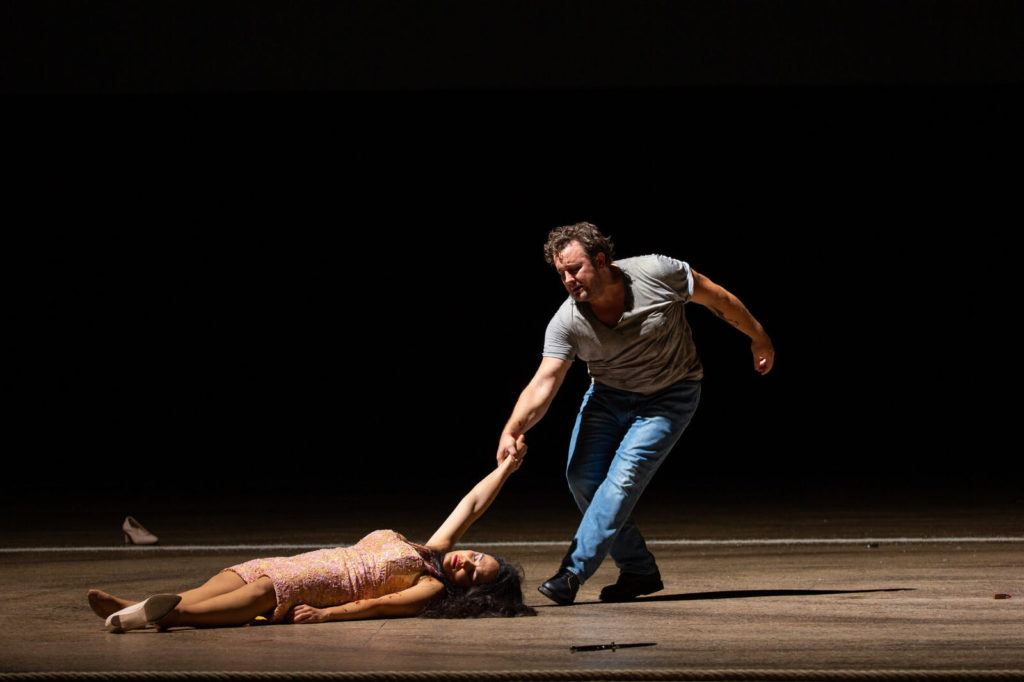
Opéra National de Paris 2022-23 Review: Carmen
Gaëlle Arquez & Michael Spyres Shine in Calixto Bieito’s Complex Production
By João Marcos CopertinoThis review is based on performances on Nov. 15 & 18, 2022.
In every opera house, there is always an informal smoker’s meeting outside in the entr’acte. It is the best place to “feel the mood” of how an opera performance is being received. Hence, I am there solely for journalistic reasons, and nothing more.
On this occasion, I went to check it out while the Opéra National de Paris was staging “Carmen.” A very sympathetic opera neophyte told me how surprised he was that the opera is sung entirely in French. He had always thought “Carmen” was written in Spanish. It was an absurd claim, so I decided to move to another smoker. But everyone there agreed on how Spanish Carmen” is. It was a miracle: a French opera—the frenchiest of all operas—is after all as Spanish as can be.
Making Carmen “Spanish” Again
Calixto Bieito’s once polemical staging indeed makes Carmen Spanish (again). He does that by making the opera also more about Spanish manhood than about Carmen’s ideals of freedom. The transfer of the action from nineteenth-century Seville to Franco’s Spain situates it in a state where nationhood and masculinity were inextricably tied together.
This masculinity extravaganza is a homoerotic paradise. The male body is exploited to exhaustion. After the prelude, a rather ripped man runs, carrying a rifle, inhis underpants. Only after Micaela leaves the stage does he stop, falling down as if he were dead, a victim of his own performance of eroticism. Shirtless men are ubiquitous throughout opera. Worry not, however: no one will see the abs of the chorus singers; Bieito hired actors for the skin work. In the third act entr’acte, when the tender music from the harp and the flute resonates in the hall, a soldier undresses himself and, nude, pretends to be a bullfighter—one of the many things that might make “Carmen” so Spanish. The (Spanish) a male ideal, then, is constituted through the appropriation and enjoyment of the national symbols.
Women, on the other hand, embrace these national symbols only when seeking something. The Roma women in particular are quite effective in playing the Spanish national symbols to their advantage. When Mercédès and Frasquita are going to deal with the board officers, they start to dress as flamenco dancers, as if they can seduce a man by performing a nationality. To be fair, the hybrid nature of the Romani is a long-standing trope in literature, very much present in Mérimée’s “Carmen.” Bieito, however, makes it different; in his production, it is not so much about the seducers as about the psyche of those seduced.
Bieito links national chauvinism to female oppression in way that recalls Almodóvar: his women strive to navigate a Nation not made for them. Carmen, in the first act, is handcuffed to a large pole with a huge Spanish flag. This very same flag literally suffocates a woman in the end of act one. In the second act, there is a gentle little girl who acts as Mercédès’ daughter. She decorates a Christmas tree with little Spanish flags, as if it is she is the only honest caretaker of nationhood. This very same girl is often protected by her mother while a Spanish soldier insinuates feeling some impure interest in the girl.
The main confrontation between the national male and the liminal female is the final duet. There is a clay representation of a bullfight arena on the floor. Carmen shines in her golden dress and, for now, she is as Spanish as her lover, the torero Escamillo. However, she is now part of the bullfighting game. Despite her best efforts, she will die in the center of a manhood staged in its most Spanish way.
This “Carmen” is a Calixto Bieito staging, which means that many already hated it before they left their houses for the theater. However, his “Carmen” works particularly well in making opera singers look good. The stage is almost bare, so much of the scenic tension is build upon physical movement. The chorus singers are used to construct the scenario in such a way that we barely see Carmen’s entrance. She is arguing over a public phone—with whom? We will never know. It is a subtle way of stressing how she was living her life all by herself, not even waiting for her cue to enter. The singers are never forced into any movement that would actively prevent their singing; at the same time, everything looks so flawless and natural in a way that is rare in opera.

Complimentary Stars
In a production that exploits very normative displays of male bodies—a hairy Abercrombie ad, if you will—, Michael Spyres’ first appearance is rather remarkable. Scenically, he is there, lighting a cigarette against the flagpole, wearing his military costume. It is evident, even before he has opened his mouth, that he is and will be the most interesting man on the stage. Musically, Spyres is great. The voice in its prime, the phrasing is almost spotless. His duo with Micaela works as a conflicted tale of desire. It already foretells the production’s reading of Don José’s mental instability as something he has always had, as opposed to his merely being conflicted because of Carmen. His final duo with Carmen in particular, I thought, was musically and scenically integrated with Bieito’s staging in a way that made it hard to not feel a little bad for the murderer. After all, he is a man of his time, infantile in his management of his emotions. Spyres nailed it.
Gaëlle Arquez’s Carmen works well in a completely different tone. She is also an impressive stage presence, even though she is not the most natural of actresses. What is especially impactful is how correct her voice sounds for Carmen’s role. The Roma character has been sung by many singers of different fachs, but there is something special when the role is sung by a real mezzo-soprano. Arquez has the perfect vocal color for the role, especially in her low notes, which are so homogenous with her higher voice. It is beautiful to listen to. Her Carmen, however, might sound even better in the Opéra-Comique—where she will sing it next spring.
Maybe the artist who suffers the most from Bastille’s unfair acoustics—and some orchestral abuses—was the charming Golda Schultz. Her Micaëla is the sweetest figure in such a drama-driven opera. Youngish, loving, and tender, Schultz indeed has a great capacity for creating complex musical phrases that lower the tension. She is the opera’s (unsuccessful) peacemaker. Her pianissimos in the third act aria were greatly done and showed an artistic consistency throughout the night. The problem is that the orchestra often covers the singers, and especially Schultz, when there is no necessity to do so. I watched her in two different occasions in two different spots of the house, and was impressed both times by the confrontation between her artistry and a less tender orchestra.
Lucas Meachem’s Escamillo lacks stamina and charm. He has a beautiful higher register, but he cannot transfer this capacity to his lower register. In fact, that the most memorable thing in Escamillo’s aria is Frasquita’s high note proves that something has gone wrong. To be fair, Bieito’s staging cuts most of the dialogue, and makes him a particularly obnoxious character—distributing money instead of being admired during his great musical moment. He is, after all, a symbol of this Spanish masculinity; however, little was done vocally to lift Bizet’s score.
Uneven in the Pit
Andrea Cueva Molnar and Adèle Charvet are very great as Frasquista and Mercédès. Nowadays it has become hard to defend their unnecessarily scenic hostility towards each other. But musically they both showcase great and promising voices. Charvet has already sung Carmen—last season in Bordeaux. And Cueva Molnar was sonorous even in Bastille. Both are promising singers to keep an eye on.
Fabien Gabel does an uneven job from the pit. The orchestra has good moments, especially in the first and fourth act, but the third act is very rough. As stated before, I could not see why Gabel elicits such massive sound against Schultz’s effective instrument in the third act aria. Even the entr’acte is rather ungraceful. The flute and harp duo was almost off of synchrony in the two performances I listened to. Even Arquez is smashed by the orchestra in the card scene… Maybe it is just a matter of time. Gabel will conduct “Carmen” until February, so much can still be done.
Bieito’s Spanish “Carmen” has been around for more than 20 years, and one hopes that it will be around for 20 more years. As long as it is possible to see it in Paris, one should try to do so.


